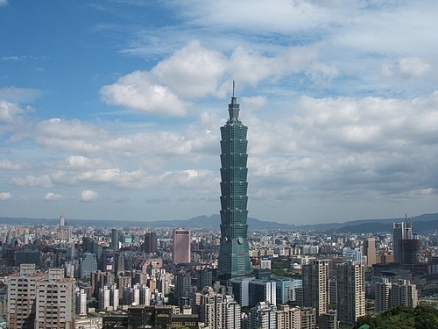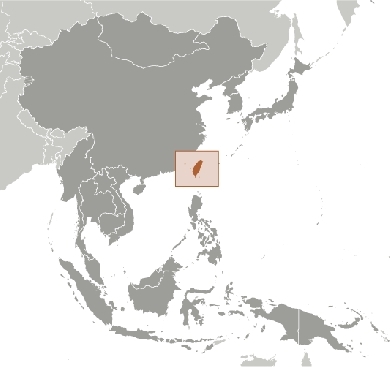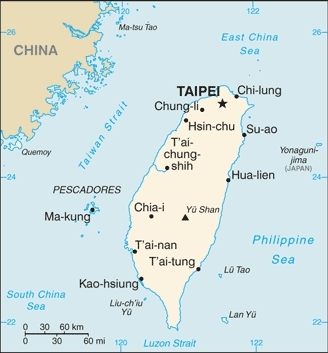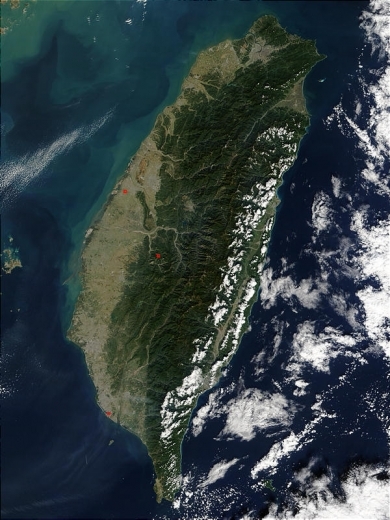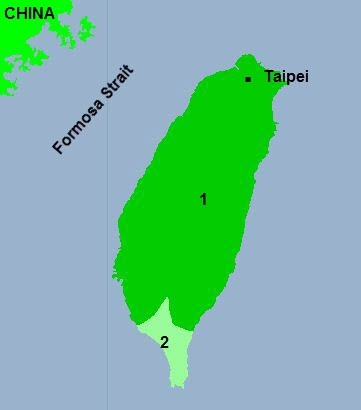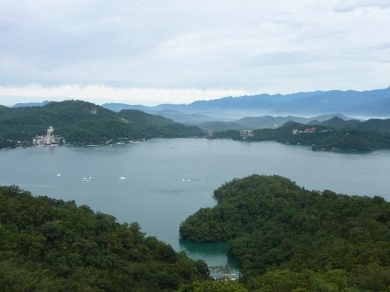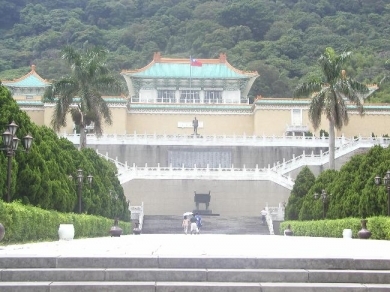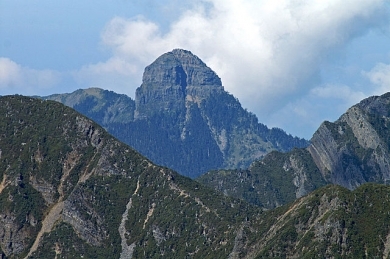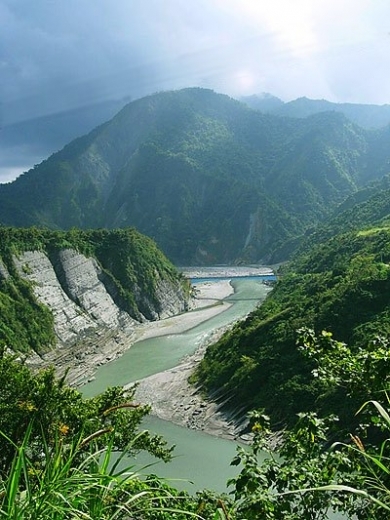Taiwan
| Topics: |
Countries and Regions of the World Collection  Taiwan is largest island off the off the southeastern coast of China, which, with several lesser islands (Pescadores, Matsu, and Quemoy) is a separately governed entity from the mainland People's Republic of China (PRC)
Taiwan is largest island off the off the southeastern coast of China, which, with several lesser islands (Pescadores, Matsu, and Quemoy) is a separately governed entity from the mainland People's Republic of China (PRC)
With twenty-three million people, and 200 kilometers (km) off the coast of China, it borders the East China Sea, Philippine Sea, South China Sea, and Taiwan Strait, north of the Philippines,
Most of the island is mountainous. Several ranges trend from northeast to southwest, and the highest peaks approach 4,000 m. The east side of the island rises steeply from the Pacific, while the west side includes some coastal plains that lie adjacent to the East China Sea. The mountains are high enough so that summits higher than 3,000 m receive some winter snow.
|
The island of Taiwan sits off of the coast of southern China between the East China Sea, the South China Sea, southwestern Japan’s Nansei-shoto Islands, and the Pacific Ocean. The island is mostly mountainous in the east, but gradually transitions to gently sloping plains in the west. At the northern tip of the island is Taiwan’s capital city, Taipei, which appears as a large grayish patch surrounded by dark green. In this image, most of Taiwan’s eastern coast is dotted with low clouds, with low and high clouds off the coast in the Pacific Ocean. MODIS also detected three fires, which are marked in red. This true-color Terra MODIS was acquired December 15, 2002. Source: NASA. Credit: Jeff Schmaltz, MODIS Rapid Response Team, NASA/GSFC |
|
Ecoregions of Taiwan. Taiwan subtropical evergreen forests (1) occupy most of the island while South Taiwan monsoon rain forests (2) cover the southern tip. Source: WWF |
| Sun Moon Lake is situated in Nantou County, Taiwan. The lake's name is derived from its shape, with the eastern side said to resemble the sun and the western side the moon. Although a natural hydrologic feature, the lake was expanded in size during the period of Japanese occupation when water from a nearby river was channeled into it for the purpose of hydropower generation. The area surrounding the lake has historically been occupied by the Thao people, one of Taiwan's aboriginal tribes. Sun Moon Lake was a favorite recreation spot of former Republic of China leader Chiang Kai-shek and it is a popular tourist destination today. |
| Approaching the National Palace Museum in Taipei. |
| Da ba jian Mountain. Source: Wikimedia Commons. |
| Siouguluan River in Taiwan. Source: Wikimedia Commons |
Its major environmental issues include:
- air pollution;
- water pollution from industrial emissions and raw sewage;
- contamination of drinking water supplies;
- trade in endangered species; and,
- low-level radioactive waste disposal
In 1895, military defeat forced China to cede Taiwan to Japan. Taiwan reverted to Chinese control after World War II.
Following the Communist victory on the mainland in 1949, 2 million Nationalists fled to Taiwan and established a government using the 1947 constitution drawn up for all of China.
Over the next five decades, the ruling authorities gradually democratized and incorporated the local population within the governing structure.
In 2000, Taiwan underwent its first peaceful transfer of power from the Nationalist to the Democratic Progressive Party. Throughout this period, the island prospered and became one of East Asia's economic "Tigers."
The dominant political issues continue to be the relationship between Taiwan and China - specifically the question of Taiwan's eventual status - as well as domestic political and economic reform.
Contents
Geography
Location: Eastern Asia, islands bordering the East China Sea, Philippine Sea, South China Sea, and Taiwan Strait, north of the Philippines, off the southeastern coast of China
Geographic Coordinates: 23 30 N, 121 00 E
Area: 35,980 sq km (land: 32,260 sq km; water: 3,720 sq km) Note: includes the Pescadores, Matsu, and Quemoy islands
Coastline: 1,566.3 km
Maritime Claims:
Natural Hazards: earthquakes; typhoons
Volcanism: Kueishantao Island (elev. 401 m), east of Taiwan, is its only historically active volcano, although it has not erupted in centuries
Terrain: eastern two-thirds mostly rugged mountains; flat to gently rolling plains in west. The highest point is Yu Shan (3,952 m).
Climate: tropical; marine; rainy season during southwest monsoon (June to August); cloudiness is persistent and extensive all year.
Ecology and Biodiversity
Taiwan includes two ecoregions. Taiwan subtropical evergreen forests occupy most of the island while South Taiwan monsoon rainforests cover the southern tip.
Of course, with 23 million people and a vigorous economy based on agriculture and industry, Taiwan’s natural environments have been severely affected by people. Most of the natural habitat occurs in mountain areas where several nature reserves and national parks have been established. Today, forest cover is estimated to be about 52 percent of the total land area, although much of this consists of non-native tree plantations.
Taiwan subtropical evergreen forests are dominated by broadleaved species. But the island’s topographic complexity means that many different forest types occur at different elevations on slopes of different aspect. MacKinnon et al. observed that these forests tend to form concentric rings around the island, like the lines on a topographic map, as elevation increases toward the interior. Despite this complexity, the overall forest zonation sequence seems to follow a pattern that re-occurs in mountain ranges throughout subtropical East Asia. As elevation increases, evergreen broadleaved forests are gradually replaced by deciduous hardwoods and conifers.
South Taiwan monsoon rain forests of South Taiwan are quite similar in their ecology and species composition to the coastal forests of southeastern mainland China (Guangdong and Guangxi Provinces). This southern part of Taiwan also supports coastal mangrove forest (Mangrove ) communities
Taiwan has an extensive protected area network that includes both coastal and mountain habitats. However, as in many places throughout the world, the protected area network protects a higher proportion of habitat in montane areas than in the coastal lowlands, which have been densely settled and intensely farmed for many centuries. Both national parks and nature reserves are better demarcated and described here than they are in most of China. MacKinnon et al. provide a comprehensive account. A summary is provided here. Some of the larger protected areas include Yushan National Park (1,055 km2), Shei-Pa National Park (769 km2), and Taroko National Park (920 km2). Yunshan includes high [[mountain]s], mostly over 2,000 m.
Kenting National Park (326 square kilometers [km2]) protects natural habitat at the southern tip of Taiwan. It includes both marine and terrestrial habitat and is heavily affected by tourism. The park provides winter habitat at Lungluan Lake for shorebirds and waterfowl that migrate from breeding areas in Japan and the Russian Far East.
See also:
People and Society
Population: 23,113,901 (July 2012 est.)
Taiwan has a population of 23 million. More than 18 million, the "native" Taiwanese, are descendants of Chinese who migrated from Fujian and Guangdong Provinces on the mainland, primarily in the 18th and 19th centuries. The "mainlanders," who arrived in Taiwan after 1945, came from all parts of mainland China. About half a million indigenous peoples inhabit the mountainous central and eastern parts of the island and are believed to be of Malayo-Polynesian origin. Of Taiwan's total population, approximately one million, or 4.4%, currently reside in mainland China (P.R.C.), according to an unofficial estimate. But according to P.R.C. population census statistics, the number of registered Taiwanese residents in China totaled 170,283 in 2010.
Ethnic Groups: Taiwanese (including Hakka) 84%, mainland Chinese 14%, indigenous 2%
Age Structure:
0-14 years: 15.6% (male 1,875,359/female 1,732,007)
15-64 years: 73.4% (male 8,538,881/female 8,406,716)
65 years and over: 10.9% (male 1,198,591/female 1,320,225) (2011 est.)
Population Growth Rate: 0.171% (2012 est.)
Birthrate: 8.81 births/1,000 population (2012 est.)
Death Rate: 7.12 deaths/1,000 population (July 2012 est.)
Net Migration Rate: 0.03 migrant(s)/1,000 population (2012 est.)
Life Expectancy at Birth: 78.48 years
male: 75.66 years
female: 81.53 years (2012 est.)
Total Fertility Rate: 1.16 children born/woman (2012 est.)
Languages: Mandarin Chinese (official), Taiwanese (Min), Hakka dialects.
A large majority of people in Taiwan speak Mandarin Chinese, which has been the medium of instruction in the schools for more than 5 decades. Native Taiwanese and many others also speak one of the Southern Fujianese dialects, Min-nan, also known as Taiwanese. Recently there has been a growing use of Taiwanese in the broadcast media. The Hakka, who are concentrated in several counties throughout Taiwan, have their own distinct dialect. As a result of the half-century of Japanese rule, many older people also can speak Japanese. The method of Chinese romanization most commonly used in Taiwan is the Wade-Giles system. In 2002, Taiwan authorities announced adoption of the pinyin system used on the mainland to replace the Wade-Giles system, but its use is not consistent throughout society, often resulting in two or more romanizations for the same place or person.
Literacy (age 15 and over can read and write): 96.1% (2003)
Education: Since 1968, 6 years of elementary school and 3 years of junior high have been compulsory for all children. About 98% of junior high graduates continue their studies in either a senior high or vocational school. Taiwan has an extensive higher education system with 165 institutions of higher learning. In 2010, about 147,561 applied for admission to universities and colleges through a modified multi-channel admissions system; 100% of the applicants were offered placement and 76% of the candidates actually enrolled. Opportunities for graduate education are expanding in Taiwan, but many students travel abroad for advanced education. Taiwan ranks fifth as a source of international students in the United States, with 24,818 studying in the United States during the 2010-2011 academic years.
Religions
According to Taiwan's Government Information Office, there are about 11.2 million religious believers in Taiwan, with more than 75% identifying themselves as Buddhists or Taoists. There is also a strong belief in traditional folk religion throughout the island. These are not mutually exclusive, and many people practice a combination of the three. Confucianism also is an honored school of thought and ethical code. Christian churches have been active on Taiwan for many years, and today, the population includes a small but significant percentage of Christians.
Culture
Taiwan's culture is a blend of its distinctive Chinese, Japanese, and Western influences. Fine arts, folk traditions, and popular culture embody traditional and modern, Asian, and Western motifs. Since the 1970s, as democracy and social openness has thrived, Taiwan's cultural diversity has flourished. In recent years, Taiwan has viewed its music, film, and crafts as "soft power" tools aimed at increasing understanding around the world and improving relationships with mainland China through tools such as museum and artistic exchanges. One of Taiwan's greatest attractions is the National Palace Museum, which houses over 650,000 pieces of Chinese bronze, jade, calligraphy, painting, and porcelain. This collection was moved from the mainland in 1949 when Chiang Kai-shek's Nationalist Party (KMT) fled to Taiwan. The collection is so extensive that only 1% is on display at any one time.
History
Taiwan's indigenous peoples, who originated in Austronesia and southern Asia, have lived on Taiwan for 12,000 to 15,000 years. Significant migration to Taiwan from the Chinese mainland began as early as A.D. 500. Dutch traders first claimed the island in 1624 as a base for Dutch commerce with Japan and the China coast. Two years later, the Spanish established a settlement on the northwest coast of Taiwan, which they occupied until 1642 when they were driven out by the Dutch. Dutch colonists administered the island and its predominantly aboriginal population until 1661. The first major influx of migrants from the Chinese mainland came during the Dutch period, sparked by the political and economic chaos on the China coast during the Manchu invasion and the end of the Ming Dynasty.
In 1664, a fleet led by the Ming loyalist Cheng Ch'eng-kung (Zheng Chenggong, known in the West as Koxinga) retreated from the mainland and occupied Taiwan. Cheng expelled the Dutch and established Taiwan as a base in his attempt to restore the Ming Dynasty. He died shortly thereafter, and in 1683, his successors submitted to Manchu (Qing Dynasty) control. From 1680, the Qing Dynasty ruled Taiwan as a prefecture and, in 1875, divided the island into two prefectures, north and south. In 1887 the island was made into a separate Chinese province.
During the 18th and 19th centuries, migration from Fujian and Guangdong provinces steadily increased, and Chinese supplanted indigenous peoples as the dominant population group. In 1895, a weakened Imperial China ceded Taiwan to Japan in the Treaty of Shimonoseki following the first Sino-Japanese war.
During its 50 years (1895-1945) of rule, Japan expended considerable effort in developing Taiwan's economy. At the same time, Japanese rule led to the "Japanization" of the island, including compulsory Japanese education and pressuring residents of Taiwan to adopt Japanese names.
At the end of World War II in 1945, Taiwan reverted to Chinese rule. During the immediate postwar period, the KMT administration on Taiwan was repressive and corrupt, leading to local discontent. Anti-mainlander violence flared on February 28, 1947, prompted by an incident in which a cigarette seller was injured and a passerby was shot to death by Nationalist authorities. The island-wide rioting was brutally put down by Nationalist Chinese troops, who killed thousands of people. As a result of the February 28 Incident, the native Taiwanese felt a deep-seated bitterness toward the mainlanders. For 50 years the KMT authorities suppressed accounts of this episode in Taiwan history. In 1995 a monument was dedicated to the victims of the "2-28 Incident," and for the first time, Taiwan's leader, President Lee Teng-hui, publicly apologized for the Nationalists' brutality.
Starting before World War II and continuing afterward, a civil war was fought on the mainland between Chiang Kai-shek's KMT government and the Chinese Communist Party led by Mao Zedong. When the civil war ended in 1949, 2 million refugees, predominately from the Nationalist government, military, and business community, fled to Taiwan. In October 1949 the People's Republic of China (P.R.C.) was founded on the mainland by the victorious communists. Chiang Kai-shek established a "provisional" Republic of China (R.O.C.) capital in Taipei in December 1949. During the 1950s, the KMT authorities implemented a far-reaching and highly successful land reform program on Taiwan. They redistributed land among small farmers and compensated large landowners with commodities certificates and stock in state-owned industries. Although this left some large landowners impoverished, others turned their compensation into capital and started commercial and industrial enterprises. These entrepreneurs were to become Taiwan's first industrial capitalists. Together with refugee businessmen from the mainland, they managed Taiwan's transition from an agricultural to a commercial, industrial economy.
Taiwan has developed steadily into a major international trading power with $526 billion in two-way trade (2010). Taiwan's accession to the World Trade Organization in 2002 has expanded its trade opportunities and further strengthened its standing in the global economy. Prosperity on the island has been accompanied by economic and social stability. Chiang Kai-shek's successor, his son Chiang Ching-kuo, began to liberalize Taiwan's political system, a process that accelerated when President Lee Teng-hui took office in 1988. The direct election of Lee Teng-hui as president in 1996 was followed by opposition Democratic Progressive Party (DPP) candidate Chen Shui-bian's election victory in March 2000, marking the first peaceful democratic transfer of power between parties in Taiwan.
Government
The President is both leader of Taiwan and Commander-in-Chief of its armed forces. The President has authority over four of the five administrative branches (Yuan): Executive, Control, Judicial, and Examination. The President appoints the President of the Executive Yuan, who also serves as the Premier. The Premier and the cabinet members are responsible for government policy and administration. The fifth administrative branch is the Legislative Yuan.
From 1949 until 1991, the authorities on Taiwan claimed to be the sole legitimate government of all of China, including the mainland. In keeping with that claim, when the Kuomintang retreated to Taiwan in 1949, they re-established the full array of central political bodies that had existed on the mainland. While much of this structure remains in place, the authorities on Taiwan in 1991 abandoned their claim of governing mainland China, stating that they do not "dispute the fact that the P.R.C. controls mainland China." The authorities in Taipei exercise control over Taiwan, Kinmen, Matsu, Penghu (Pescadores), and several other smaller islands.
In 1994 the Legislative Yuan passed legislation allowing for the direct election of the Governor of Taiwan Province and the mayors of Taipei and Kaohsiung Special Municipalities. At the end of 1998, the Constitution was amended to make all counties and cities directly administered by the Executive Yuan. The position of elected Governor was abolished in a move to streamline administration, and most other elements of the Taiwan Provincial Government have been eliminated. Taiwan is divided into counties, provincial municipalities, and, since December 2010, five special municipalities--Taipei, New Taipei City, Greater Taichung, Greater Tainan, and Greater Kaohsiung, the last three representing a merger of cities and counties. Legislative Branch
The first National Assembly, elected on the mainland in 1947 to carry out the duties of choosing the President and amending the constitution, was re-established on Taiwan when the KMT moved. Because it was impossible to hold subsequent elections to represent constituencies on the mainland, representatives elected in 1947-48 held these seats "indefinitely." In June 1990, however, the Council of Grand Justices mandated the retirement, effective December 1991, of all remaining "indefinitely" elected members of the National Assembly and other bodies. The second National Assembly, elected in 1991, was composed of 325 members. The majority were elected directly, while 100 were chosen from party slates in proportion to the popular vote. This National Assembly amended the Constitution in 1994, paving the way for direct elections of the President and Vice President, the first of which was held in March 1996. In April 2000, the members of the National Assembly voted to permit their terms of office to expire without holding new elections.
The Legislative Yuan (LY) was originally elected in the late 1940s in parallel with the National Assembly. The first LY had 773 seats and was viewed as a "rubber stamp" institution. The second LY was not elected until 1992. The third LY, elected in 1995, had 157 members serving 3-year terms, while the fourth LY, elected in 1998, was enlarged to 225 members. The National Assembly that was elected in May 2005 passed a set of constitutional amendments in June 2005 that abolished the National Assembly, leaving Taiwan with a unicameral legislature; halved the number of LY seats from 225 to 113 and created single-member legislative election districts beginning with the January 2008 legislative election; and provided for the public to confirm or reject future constitutional amendments passed by the LY. The LY has greatly enhanced its standing in relation to the Executive Yuan and has established itself as a major player on the central level. With increasing strength and complexity, the LY mirrors Taiwan's liberalized political system.
Other Branches
The Control Yuan (CY) monitors the efficiency of public service and investigates instances of corruption. The 29 Control Yuan members are appointed by the President and approved by the Legislative Yuan; they serve 6-year terms. In recent years, the Control Yuan has become more active, and it has conducted several major investigations and impeachments. From January 2005 to August 2008, the Control Yuan was inactive because the Pan-Blue dominated LY refused to approve the new slate of CY members proposed by President Chen. The new Control Yuan members appointed by President Ma Ying-jeou took office on August 1, 2008.
The Judicial Yuan (JY) administers Taiwan's court system. It includes a 15-member Council of Grand Justices (COGJ) that interprets the constitution. Grand Justices are appointed by the President, with the consent of the Legislative Yuan, to 8-year terms.
The Examination Yuan (EY) functions as a civil service commission and includes two ministries: the Ministry of Examination, which recruits officials through competitive examination, and the Ministry of Personnel, which manages the civil service. The President appoints the President and members of the Examination Yuan.
Government Type: multiparty democracy
Capital: Taipei
Administrative divisions: includes main island of Taiwan plus smaller islands nearby and off coast of China's Fujian Province; Taiwan is divided into 14 counties (hsien, singular and plural), 3 municipalities (shih, singular and plural), and 5 special municipalities (chih-hsia-shih, singular and plural). Note: Taiwan uses a variety of romanization systems; while a modified Wade-Giles system still dominates, the city of Taipei has adopted a Pinyin romanization for street and place names within its boundaries; other local authorities use different romanization systems; names for administrative divisions that follow are taken from the Taiwan Yearbook 2007 published by the Government Information Office in Taipei.
counties: Changhua, Chiayi (county), Hsinchu (county), Hualien, Kinmen, Lienchiang, Miaoli, Nantou, Penghu, Pingtung, Taitung, Taoyuan, Yilan, Yunlin
municipalities: Chiayi (city), Hsinchu (city), Keelung
special municipalities: Kaohsiung, New Taipei, Taichung, Tainan, Taipei
Legal System: civil law system. Taiwan has not submitted an International Court of Justice (ICJ) jurisdiction declaration; non-party state to the International criminal court (ICCt).
Taiwan and the Mainland: Over the past several years, Taiwan has relaxed restrictions on unofficial contacts with the P.R.C., and cross-Strait interaction has increased substantially. In January 2001, Taiwan formally allowed the "three mini-links" (direct trade, travel, and postal links) from Kinmen (Quemoy) and Matsu Islands to Fujian Province and permitted direct cross-Strait trade in February 2002. Cross-Strait trade has grown rapidly over the past 10 years. China is Taiwan's largest trading partner, and Taiwan is China's seventh-largest. Estimates of Taiwan investment on the mainland, both officially approved by Taiwan authorities and investment made by Taiwan firms through third parties, range from $110 billion to over $300 billion, making Taiwan and Hong Kong by some measures the two largest investors in the P.R.C. This trade generally runs in Taiwan's favor and continues to grow, providing another engine for the island's economy. On June 29, 2010, following 6 months of negotiations, the two sides signed an Economic Cooperation Framework Agreement (ECFA), aimed at bringing about liberalization of cross-Strait trade in products and services and eventually creating an essentially free-trade regime. ECFA came into force on September 12, 2010. A 2-year phase-in period began on January 1, 2011 for bilateral reduction and elimination of tariffs affecting more than 800 products. Ma administration officials see ECFA as a critical first step in avoiding Taiwan's regional economic marginalization, paving the way for expanded trade relations with the Association of Southeast Asian Nations (ASEAN), the United States, and other major trading partners.
In February 2003, Taiwan and the P.R.C. agreed to allow Taiwan carriers to fly non-stop (although routed via Hong Kong or Macau airspace) to take Taiwan residents on the mainland home for the Lunar New Year holiday. The two sides agreed to conduct Lunar New Year charter flights again in 2005, with flights operated by both Taiwan and P.R.C. carriers flying over, but not having to land in, Hong Kong or Macau. Over time these flights were expanded to cover three other major holidays. In July 2008, Taiwan and P.R.C. carriers began operating cross-Strait charter flights every weekend. These flights are open to mainland tourists, as well as Taiwan and foreign travelers. Daily direct cross-Strait charter flight service began in December 2008, and the two sides have also begun cargo charter flights, direct shipping, direct postal service, and cooperation on food safety issues. To meet rapidly increasing air transport demand, both parties agreed to increase the number of passenger and cargo flights to 270 per week in 2009; carriers from each side operate 135 flights per week. Following an agreement in May 2010, cross-Strait flights eventually increased to more than 500 per week. As of 2011, a total of 558 weekly cross-Strait flights were in operation. More than 1.72 million P.R.C. citizens visited Taiwan in 2011, including 1.31 million tourists, according to statistics released by the Mainland Affairs Council. In 2011, Taiwan agreed to open "free and individual tours" by P.R.C. citizens residing in Beijing, Shanghai, and Shenzhen. A total of 15,533 P.R.C. citizens had entered Taiwan between June and October 2011 for “free and individual tours.” Many senior P.R.C. officials--including the culture minister, a vice minister of public security, the mayor of Shanghai, and numerous provincial governors and Communist Party leaders--have visited as part of an effort to improve mainland China's image among a generally wary Taiwan population.
The development of semiofficial cross-Strait relations has had ups and downs. In April 1993, the first round of high-level cross-Strait talks was held in Singapore between the heads of two private intermediary organizations--Taiwan's Straits Exchange Foundation (SEF) and the P.R.C.'s Association for Relations Across the Taiwan Strait (ARATS). These talks primarily addressed technical issues relating to cross-Strait interactions. Beijing suspended lower-level talks from 1995-97 following President Lee's U.S. visit. SEF Chairman Koo Chen-fu visited the mainland in October 1998 for the second round of high-level talks. In 1999 Beijing once again suspended the cross-Strait dialogue, canceling plans for a visit by ARATS Chairman Wang Daohan to Taiwan, because of statements by President Lee that relations between the P.R.C. and Taiwan should be conducted as "state-to-state" or at least as "special state-to-state relations." Following his May 20, 2000 inauguration, President Chen called for resuming the cross-Strait dialogue without any preconditions, but the P.R.C. insisted President Chen first acknowledge what it claimed was the "1992 consensus" on one China reached by the two sides. The cross-Strait dialogue remained suspended for the following 8 years of President Chen's two-term administration. Nonetheless, economic and social ties continued to develop rapidly despite the "one China" obstacle and Taiwan's resentment over the P.R.C.'s March 2005 "Anti-Secession Law," and the two sides were able through intermediary organizations to reach agreements on holiday cross-Strait charter flights. The KMT began its own dialogue with Beijing in 2005.
In his first term, President Ma's administration resumed the SEF-ARATS dialogue, expanded flights, and, in a major step to enhance cross-Strait relations, signed the Economic Cooperation Framework Agreement with Beijing. The United States has welcomed and encouraged the regular cross-Strait dialogue as a process which contributes to a reduction of tension and to an environment conducive to the eventual peaceful resolution of the outstanding differences between the two sides. The United States believes differences between Taipei and Beijing should be resolved peacefully in a manner acceptable to people on both sides of the Taiwan Strait. From 2008 until 2011, SEF and ARATS held seven rounds of talks and signed 16 agreements, including the ECFA and agreements to cooperate in areas of intellectual property rights, medicine, financial services, and nuclear power safety. President Ma has stressed the importance of people-to-people contact, and in 2010 the Legislative Yuan revised the University Law, the Junior College Law, and the Cross-Strait Relations Act to allow P.R.C. college students to go to Taiwan for graduate and undergraduate degree studies. In 2011, fewer than 1,000 Chinese students pursued undergraduate and graduate studies at Taiwan's universities, even though the Ministry of Education had set a quota to allow more than 2,000 Chinese students. The Ministry of Education attributed the lower number to the many restrictions set by Taiwan authorities on what Chinese students may study and do after graduation.
International Environmental Agreements
Taiwan is party to none of the usual international agreements on because of its international status
Resources
Natural Resources: small deposits of coal, natural gas, limestone, marble, and asbestos
Land Use:
Total Renewable Water Resources: 67 cu km (2000):
Economy
Through decades of hard work and sound economic management, Taiwan has transformed itself from an underdeveloped, agricultural island to an economic power that is a leading producer of high-technology goods. In the 1960s, foreign investment in Taiwan helped introduce modern, labor-intensive technology to the island, and Taiwan became a major exporter of labor-intensive products. In the 1980s, focus shifted toward increasingly sophisticated, capital-intensive and technology-intensive products for export and toward developing the service sector. At the same time, as a result of the appreciation of the New Taiwan dollar (NT dollar or NTD), rising labor costs, and increasing environmental consciousness in Taiwan, many labor-intensive industries, such as shoe manufacturing, shifted production and moved their manufacturing to China and Southeast Asia. Taiwan has transformed itself from a recipient of U.S. aid in the 1950s and early 1960s to an aid donor and major foreign investor, especially in Asia. Taiwan is now a creditor economy, holding the world's fourth-largest stock of foreign exchange reserves ($385.6 billion as of December 2011). Although Taiwan enjoyed sustained economic growth, full employment, and low inflation for many years, in 2001, Taiwan joined other regional economies in its first recession since 1949. From 2002-2007, Taiwan's economic growth ranged from 3.5% to 6.2% per year. With the global economic downturn, Taiwan's economy slumped into recession in the second half of 2008. Its real GDP, following growth of 5.98% in 2007, rose 0.73% in 2008 and contracted 1.81% in 2009. The economy saw a robust recovery in 2010, growing by 10.72%, the highest rate in 28 years. In 2011, growth slowed to 4.03% amid the European debt crisis.
Foreign Trade
Foreign trade has been the engine of Taiwan's rapid growth during the past 50 years. Taiwan's economy remains export-oriented, so it depends on an open world trade regime and remains vulnerable to fluctuations in the world economy. The total value of trade increased more than five-fold in the 1960s, nearly 10-fold in the 1970s, doubled in the 1980s, nearly doubled again in the 1990s, and grew more than 85% in the past decade. Export composition changed from predominantly agricultural commodities to industrial goods (now 99%). The electronics sector is Taiwan's most important industrial export sector. Taiwan became a member of the World Trade Organization (WTO) as a special customs territory in January 2002.
Taiwan firms are the world's largest suppliers of computer monitors and leaders in PC manufacturing, although now much of the final assembly of these products occurs overseas, typically in China. Imports are dominated by raw materials and capital goods, which account for more than 90% of the total. Taiwan imports coal, crude oil, and gas to meet most of its energy needs. Reflecting the large Taiwan investment in China, the P.R.C. supplanted the United States as Taiwan's largest trade partner in 2003. In 2010, China (including Hong Kong) accounted for over 29.0% of Taiwan's total trade and 41.8% of Taiwan's exports. Japan was Taiwan's second-largest trading partner with 13.3% of total trade, including 20.7% of Taiwan's imports. The United States is now Taiwan's third-largest trade partner, taking 11.5% of Taiwan's exports and supplying 10.1% of its imports. In 2010, Taiwan was the United States' ninth-largest trading partner, with Taiwan's two-way trade with the United States amounting to $61.9 billion. Imports from the United States consist mostly of machinery and equipment as well as agricultural and industrial raw materials. Exports to the United States are mainly electronics and consumer goods. The United States, Hong Kong, China, and Japan account for 60% of Taiwan's exports, and the United States, Japan, and China provide almost 46% of Taiwan's imports. As Taiwan's per capita income level has risen, demand for imported, high-quality consumer goods has increased. The U.S. trade deficit with Taiwan in 2010 was $9.88 billion, down $74 million from 2009. In addition to its formal diplomatic relations, Taiwan also maintains trade offices in nearly 100 countries. Taiwan is a member of the Asian Development Bank, the WTO, and the Asia-Pacific Economic Cooperation (APEC) forum. Taiwan is also an observer at the Organization for Economic Cooperation and Development (OECD). In 2009, Taiwan acceded to the WTO Government Procurement Agreement. These developments reflect Taiwan's economic importance and its desire to become further integrated into the global economy.
Agriculture
Although less than one-quarter of Taiwan's land area is arable, virtually all farmland is intensely cultivated, with some areas suitable for two and even three crops a year. Agriculture comprises only about 1.6% of Taiwan's GDP. Taiwan's main crops are rice, fruit, and vegetables. While largely self-sufficient in rice production, Taiwan imports large amounts of wheat, corn, and soybeans, mostly from the United States. Poultry and pork production are mainstays of the livestock sector and the major demand drivers for imported corn and soybeans. Rising standards of living have led to increased demand for a wide variety of high-quality food products, much of it imported. Overall, U.S. agricultural and food products account for over 30% of Taiwan's agricultural import demand. U.S. food and agricultural exports total about $3.0 billion annually, making Taiwan the United States' sixth-largest agricultural export destination. Taiwan's agricultural exports include frozen fish, aquaculture and sea products, canned and frozen vegetables, and nursery products such as orchids. Taiwan's imports of agricultural products and the range of countries supplying the market have increased since its WTO accession in 2002, and it is slowly liberalizing previously protected agricultural markets.
Economic Outlook
Taiwan faces many of the same economic issues as other developed economies. As labor-intensive industries have relocated to countries with low-cost labor, Taiwan's future development will rely on further transformation to a high technology and service-oriented economy and carving out its niche in the global supply chain. Taiwan's economy has become increasingly linked with China, and the Ma administration is expected to further develop these links and liberalize cross-Strait economic relations, particularly through negotiations under the Economic Cooperation Framework Agreement (ECFA). Taiwan official statistics indicate that Taiwan firms had invested about U.S. $110.9 billion in China as of the end of November 2011, which is more than 60% of Taiwan's stock of direct foreign investment. Unofficial estimates put the actual number at between U.S. $150 and over $300 billion. Exact figures are difficult to obtain, as much Taiwan investment in the P.R.C. is via Hong Kong and other third-party jurisdictions. More than one million Taiwan people are estimated to be residing in China, and more than 70,000 Taiwan companies have operations there. Taiwan firms are increasingly acting as management centers that take in orders, produce them in Taiwan, the mainland, or Southeast Asia, and then ship the final products to the U.S. and other markets.
GDP: (Purchasing Power Parity): $885.3 billion (2011 est.)
GDP: (Official Exchange Rate): $504.6 billion (2011 est.)
GDP- per capita (PPP): $37,900 (2011 est.)
GDP- composition by sector:
agriculture: 1.3%
industry: 32%
services: 66.9% (2011 est.)
Agricultural products: rice, vegetables, fruit, tea, flowers; pigs, poultry; fish
Industries: electronics, communications and information technology products, petroleum refining, armaments, chemicals, textiles, iron and steel, machinery, cement, food processing, vehicles, consumer products, pharmaceuticals
Currency: New Taiwan dollars (TWD)
Transnational Issues
Taiwan is involved in complex dispute with Brunei, China, Malaysia, the Philippines, and Vietnam over the Spratly Islands, and with China and the Philippines over Scarborough Reef. The 2002 "Declaration on the Conduct of Parties in the South China Sea" has eased tensions but falls short of a legally binding "code of conduct" desired by several of the disputants.
The Paracel Islands are occupied by China, but claimed by Taiwan and Vietnam.
In 2003, China and Taiwan became more vocal in rejecting both Japan's claims to the uninhabited islands of the Senkaku-shoto (Diaoyu Tai) and Japan's unilaterally declared exclusive economic zone in the East China Sea where all parties engage in hydrocarbon prospecting
